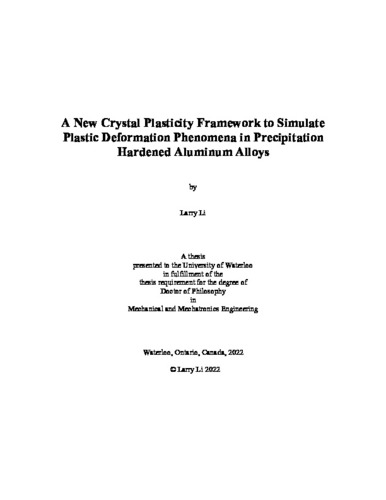| dc.contributor.author | Li, Larry | |
| dc.date.accessioned | 2022-04-26 22:27:04 (GMT) | |
| dc.date.available | 2022-04-26 22:27:04 (GMT) | |
| dc.date.issued | 2022-04-26 | |
| dc.date.submitted | 2022-04-14 | |
| dc.identifier.uri | http://hdl.handle.net/10012/18182 | |
| dc.description.abstract | This thesis outlines the development of a numerical framework for simulating aluminum alloys that exhibit the precipitation hardening phenomenon. A novel crystal plasticity-based precipitation strengthening model is introduced to predict the effects of artificial ageing on the alloy’s mechanical properties. In this model, the effect of the precipitate distribution is incorporated via two mechanisms. First, the reduction in the dislocation mean-free path is captured using a yield strength model based on the Peach-Koehler effect. Second, the strain (and stress) accumulated in the precipitates are simulated through an Eshelby inclusion homogenization scheme. The homogenization directly incorporates the orientation-dependence and morphology of the precipitates into the constitutive single crystal response. The model is then implemented into the crystal plasticity finite element method to study the bulk material properties for an AA6060-T6 alloy. The properties of this alloy are characterized using electron backscatter diffraction (EBSD) as well as mechanical testing in both tension and shear. Results of the model are presented and compared to the experiments, and an investigation is performed with the model over a range of different parameters.
To build onto the initial crystal plasticity framework, the model is subsequently modified to incorporate the effect of solute on the yield and work hardening behaviors. This is accomplished by incorporating solid solution strengthening into the model as well as a new dislocation generation factor into the hardening law. In addition, the thermodynamics of the artificial ageing process is simulated using a classical nucleation and growth (CNGT) model for AA6000-series alloys. The CNGT model is used to generate realistic distributions of precipitate over a wide range of heat treatment conditions that are subsequently used as inputs into the proposed crystal plasticity model. The results from the combined kinetics and plasticity framework are presented in a series of simulations for sheet AA6061 alloy. The material is characterized using both EBSD and mechanical testing across various heat treatment conditions to calibrate and evaluate the framework. Simulation results show the ability to predict the yield strength, work hardening, plastic anisotropy and Bauschinger effect across different tempers and demonstrates the applicability of crystal plasticity modeling in age-hardening applications. | en |
| dc.language.iso | en | en |
| dc.publisher | University of Waterloo | en |
| dc.subject | aluminum | en |
| dc.subject | crystal plasticity | en |
| dc.subject | finite element method | en |
| dc.subject | precipitation hardening | en |
| dc.subject | kinetics | en |
| dc.subject | artificial ageing | en |
| dc.title | A New Crystal Plasticity Framework to Simulate Plastic Deformation Phenomena in Precipitation Hardened Aluminum Alloys | en |
| dc.type | Doctoral Thesis | en |
| dc.pending | false | |
| uws-etd.degree.department | Mechanical and Mechatronics Engineering | en |
| uws-etd.degree.discipline | Mechanical Engineering | en |
| uws-etd.degree.grantor | University of Waterloo | en |
| uws-etd.degree | Doctor of Philosophy | en |
| uws-etd.embargo.terms | 0 | en |
| uws.contributor.advisor | Inal, Kaan | |
| uws.contributor.affiliation1 | Faculty of Engineering | en |
| uws.published.city | Waterloo | en |
| uws.published.country | Canada | en |
| uws.published.province | Ontario | en |
| uws.typeOfResource | Text | en |
| uws.peerReviewStatus | Unreviewed | en |
| uws.scholarLevel | Graduate | en |

